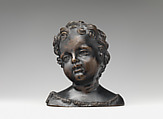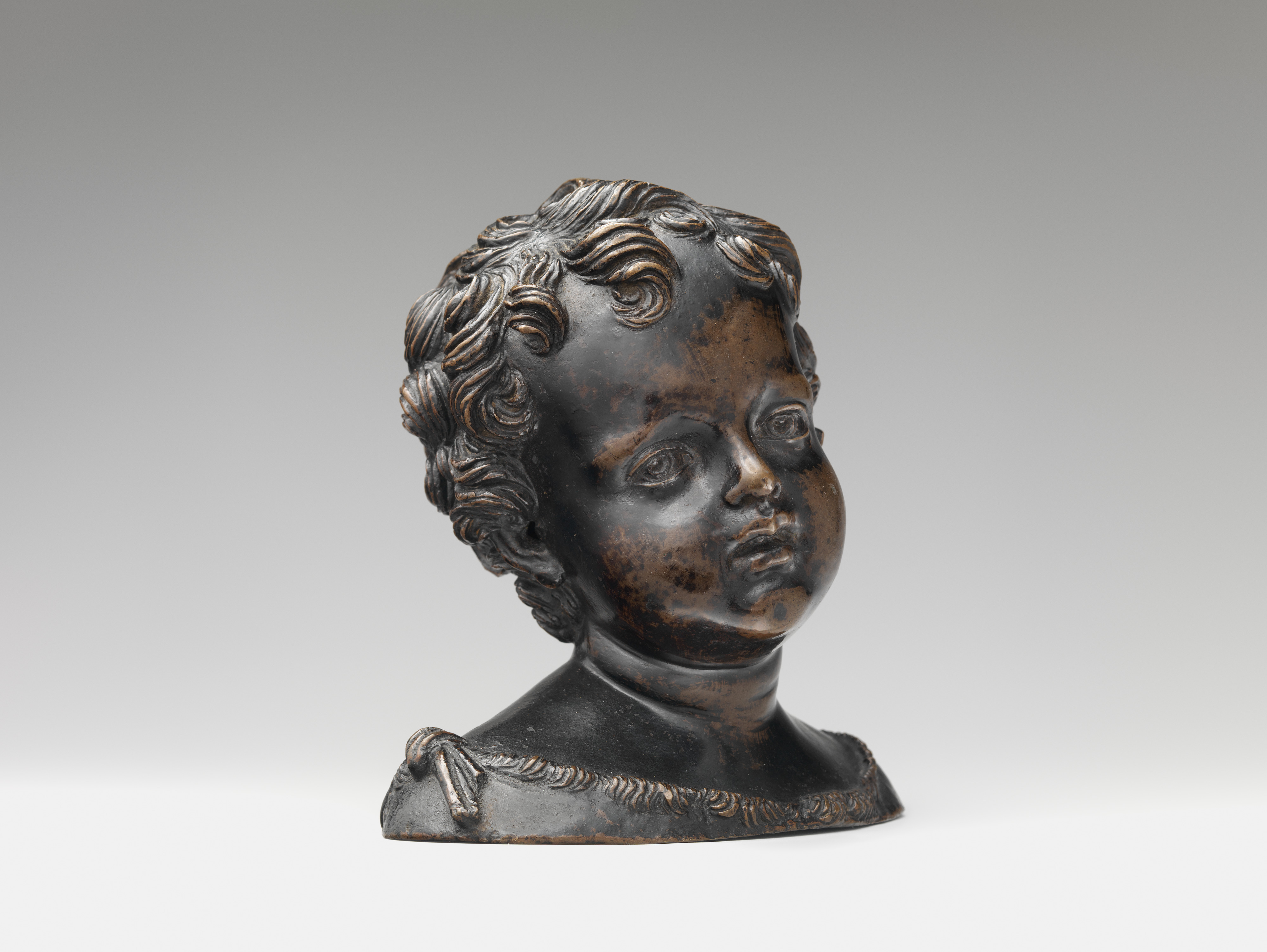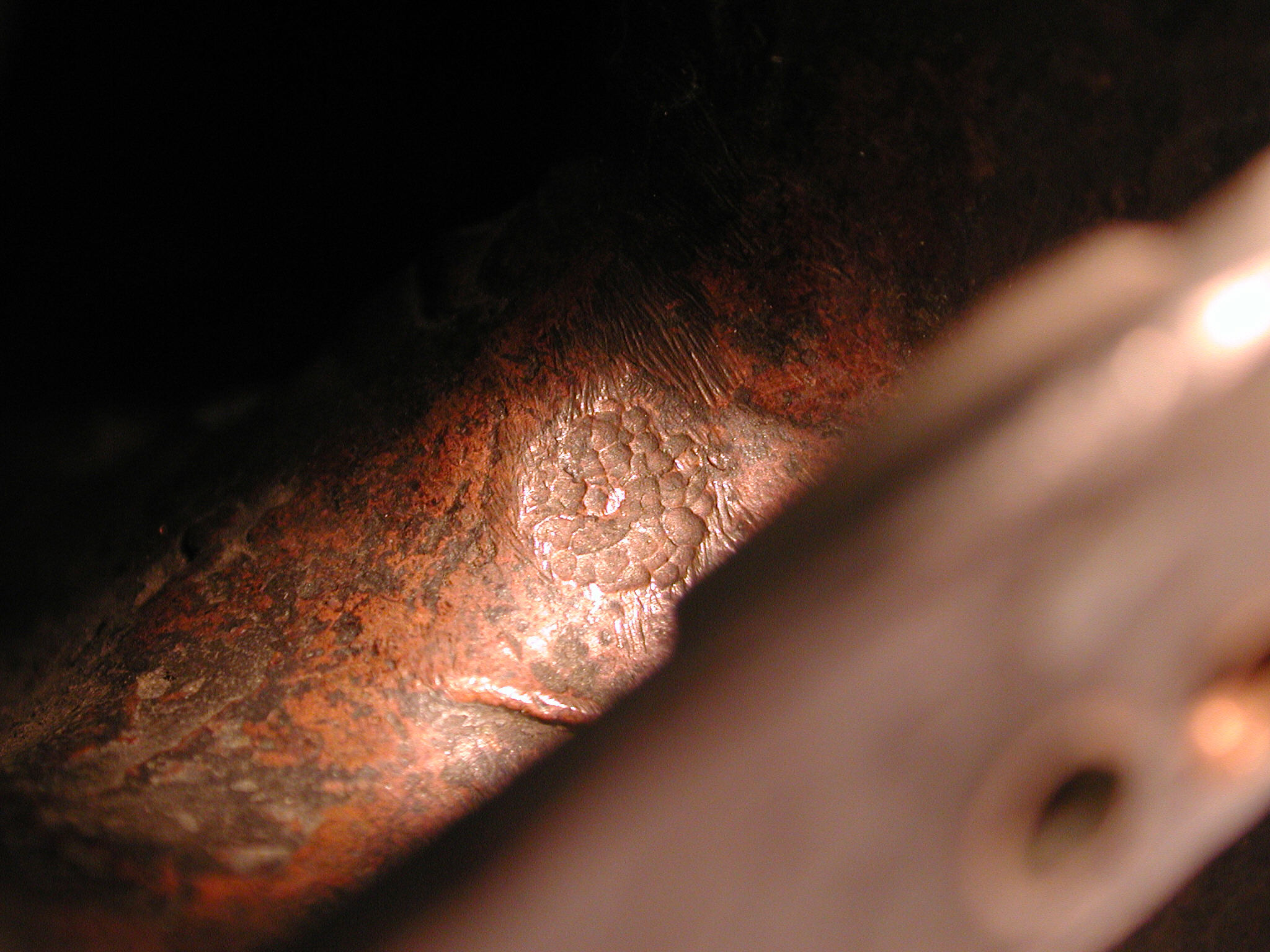Young St. John the Baptist
Circle of Antonio Lombardo Italian
Not on view
Identifiable by his fur-trimmed shirt, John the Baptist is envisaged as a cherubic infant with well-articulated curls, a high forehead, and a chubby neck. His head tilts toward his right, and his eyes peer off dreamily. His parted lips, revealing his upper teeth, suggest speaking, presaging his role as preacher. The Met’s bronze bust is one of five known casts after the same model. The others are in the Ashmolean, the Bargello, and the Museum of Fine Arts, Houston.[1] The fifth was formerly in Berlin.[2] They have long been connected to a series of ideal female bronze busts dressed all’antica suggested to have derived from the same ambit: Venice around 1500, and specifically the Lombardo workshop.[3]
The prevailing consensus is that the models for both the young John and the busts of women can be attributed to the Venetian sculptor Antonio Lombardo. They were first published by Wilhelm von Bode in 1907, who attributed the bronze boys to the Florentine sculptor Vittorio Ghiberti, son of Lorenzo.[4] In subsequent publications, Bode offered various opinions, putting forth the name Antico, and ultimately, a general Florentine milieu.[5] It was Leo Planiscig in 1937 who identified the busts as John the Baptist and connected them to the Lombardo workshop, specifically as the work of Antonio on the basis of comparison to the Christ Child in the Zen Chapel of San Marco, Venice, executed in 1506–8.[6] This ascription has been generally accepted, though later writers sometimes hedged by identifying them as in the “circle” or “manner” of.[7]
The link between the features of the young John and the Zen Chapel’s Christ Child is persuasive, as are the similarities between the bronze heads of the ideal women and female figures by Antonio in his marble reliefs.[8] There are complications regarding the division of labor in terms of the casting of figures for the Zen Chapel, and the paucity of evidence regarding Tullio’s style in bronze make an incontrovertible connection to Antonio difficult.[9] Still, the aforementioned stylistic evidence points strongly to the latter’s role in modeling the figures, as does the proposal that at least two of the bronze female busts were either sent to or produced in northern Italy during Antonio’s Ferrarese period.[10]
An open question regarding the bronzes concerns the role of Severo da Ravenna and his foundry, as first suggested by Manfred Leithe-Jasper in 1986.[11] Severo had trained with Pietro Lombardo in Venice and had close ties to the family. The finest casts of the young John—typically considered those in the Bargello and the Ashmolean—are generally dated to the sixteenth century and feature some hallmarks of bronzes that emerged from Severo’s foundry.[12] The Ashmolean cast, for example, contains four rectangular iron core-support pins that have been considered Severo’s trademark. More caution must be exercised in regards to the present bronze, which has very thin, even walls, no evidence of typical Severan plugs, and details such as the hair worked up in the wax, all at odds with the Severo shop.[13]
It is worth underlining how inventive these bronzes were in Venetian circles around 1500. Busts of young children, including those in the guise of Saint John the Baptist, had gained popularity in marble and other materials in mid-quattrocento Florence.[14] As that city’s patron saint, the appeal of the “Giovannino” type is not surprising.[15] In Venice, around 1500, the infant John began appearing with some frequency in paintings of the Virgin and Child, by Giovanni Bellini for instance. Brian Steele has explored the reasons for this, which include a new emphasis on domesticity and family life in Venice at the turn of the century.[16] Additionally, the city boasted its own connections to the saint, possessing a head relic in San Marco since the early thirteenth century.
The busts’ truncation, diminutive size, and material also contributed to their novelty. They were likely intended for a private, domestic sphere, perhaps in conversation with the heads of beautiful women, though they may also have had a devotional purpose. The present bronze has been tentatively connected to one sold from the collection of Mme d’Yvon in 1892, though this remains uncertain.[17]
-JF
Footnotes
(For key to shortened references see bibliography in Allen, Italian Renaissance and Baroque Bronzes in The Metropolitan Museum of Art. NY: The Metropolitan Museum of Art, 2022.)
1. For the Ashmolean bust (WA1963.38), see Warren 2014, pp. 148–53, no. 41, with reference to the Bargello (35), MFAH (44.588), and Met busts at p. 153, nn. 3–5 (see also C. Wilson 2001). 2. Now lost, before 1945 in the Staatliche Museen, Berlin (7185), previously in Kassel; Warren 2014, p. 153 n. 6.
3. For the busts of the ideal young women, see Warren 2016, vol. 1, pp. 218–23, no. 53, on the bronze in the Wallace Collection (S62), with reference to others in the Kunsthistorisches Museum (KK 9098), Galleria Estense, Modena (2260, 2261), and Staatliche Museen, Berlin (298) at p. 222 nn. 7–9.
4. Bode 1907–12, vol. 1, p. 8.
5. For the Antico attribution, partially on the basis of black patination (which the present bronze has as well), see Bode 1915, cols. 69–71, and the follow-up in Bode 1922, p. 5.
6. Planiscig 1937. For the Zen Chapel, see Jestaz 1986.
7. See, for example, Bode and Draper 1980, p. 89.
8. See Planiscig 1937; Luchs 1995, pp. 100–102, 173–74, 288–90; Luchs 2009, pp. 63, 89–90, 113.
9. As Alison Luchs wrote (1995, p. 99), “few works demonstrate more graphically than these bronzes the frequent difficulty of distinguishing Tullio’s work from Antonio’s . . .”
10. Antonio spent the last phase of his career working for Alfonso I d’Este in Ferrara, and the presence of the two bronze female busts in early Modenese inventories suggests these were sent there by the artist in advance of his move or modeled in Ferrara and cast in Padua. See the discussion in Warren 2014, p. 151. It was Luchs 1995, p. 173 n. 71, who suggested the Modena busts can be connected to a 1629 inventory.
11. See Leithe-Jasper 1986, p. 136.
12. See discussion in Warren 2014, p. 151, with reference to Stone 2006. It is interesting to note that XRF identified the alloy as brass, which is typical of Severo’s production. R. Stone/TR, 2011.
13. James David Draper (in Untermyer 1977, p. 164, no. 305) described it as by “a relatively heavy hand, and the features are as a result both hard and saccharine. However, the interior of the cast is briskly tooled in a way seen in good early bronzes.” One may more charitably describe the present bronze as possessing a refinement in the definition of features more characteristic of the later cinquecento.
14. See Coonin 1995 for a summary.
15. See the classic studies: Lavin 1955 and 1961.
16. See Steele 1994.
17. See Warren 2014, p. 153 n. 5, though a note in ESDA/OF suggests this may be the bronze formerly in the Philippe Wiener collection and now in Houston. The collection of Mme d’Yvon was sold at Galerie Georges Petit, Paris, May 30–June 4, 1892. Lot 276 describes a “Buste de jeune enfant. La tête légèrment penchée vers la gauche, ses cheveux sont frisés. Une peau de bête est drapée sur son épaule droite. Bronze à patine brune. Italie. XVIIe siècle. Socle en marbre.—Haut., 13 cm.” A copy of the sales catalogue contains the handwritten annotation “1600 Picard” in the margin, indicating the price and buyer.
Due to rights restrictions, this image cannot be enlarged, viewed at full screen, or downloaded.
This artwork is meant to be viewed from right to left. Scroll left to view more.




